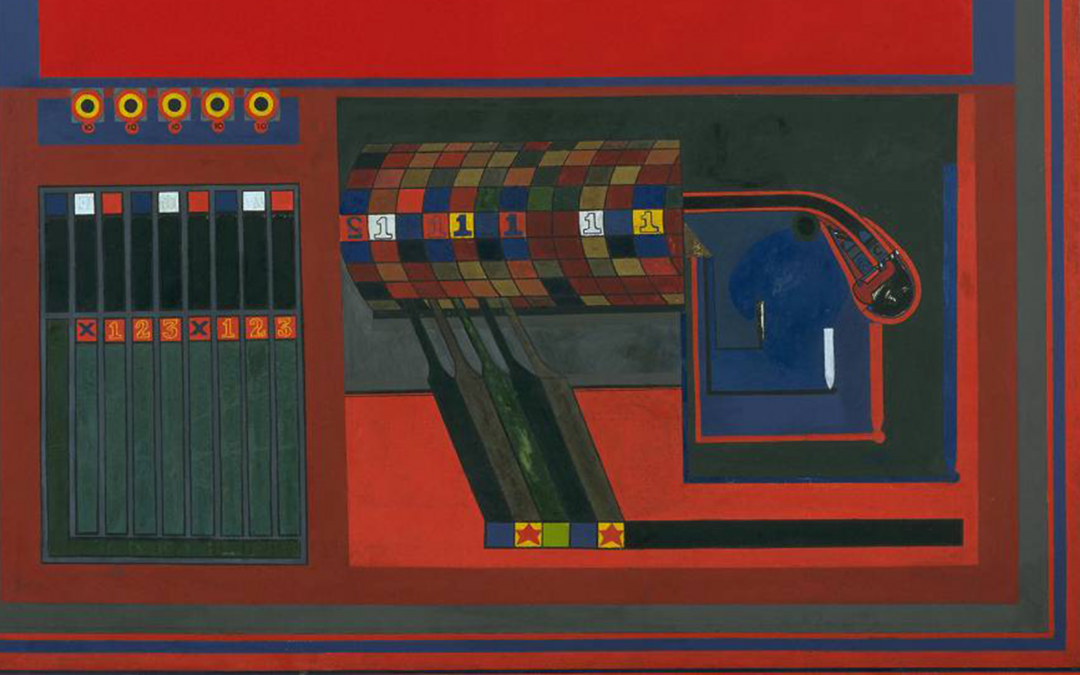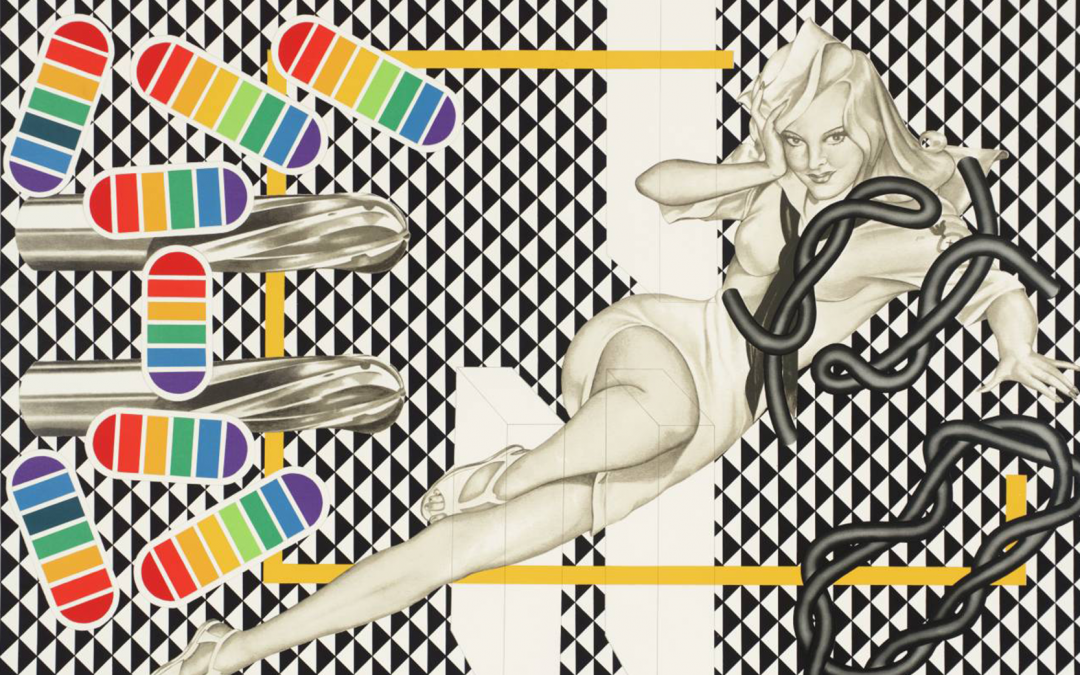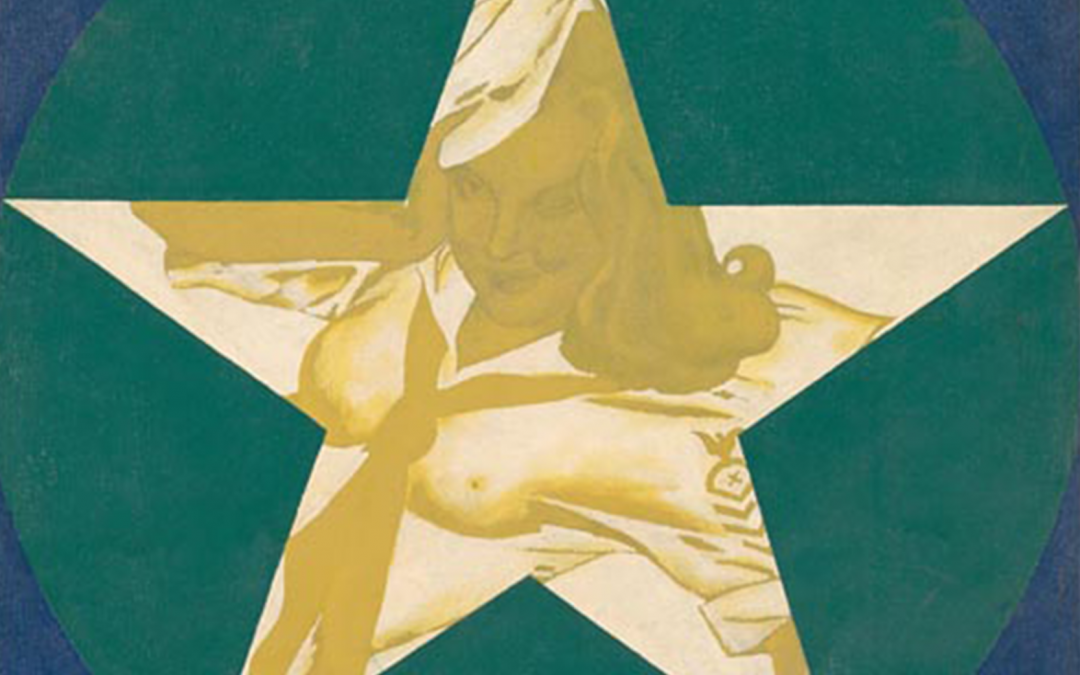No works found.
Please try a broader search.

The Tate Gallery’s homage to British Pop Art, ‘Art & the Sixties: This Was Tomorrow’, features Peter Phillips early oil on canvas, The Entertainment Machine. Of the 31 works of Peter Phillips owned by the Tate, The Entertainment Machine is a particularly important work that was originally shown in the Young Contemporaries Exhibition in 1962, and was acquired by the Tate in 1976 from the Peter Stuyvesant Foundation.
Painted in 1961 at the artist’s live/work studio on Holland Park Road in Kensington, Phillips depicted abstract imagery using a board game format as a compositional device. A recurring theme in many of Phillips’ paintings, The Entertainment Machine utilizes imagery of mechanical parts including a pistol, diagram of bullet sizes, and piano keyboard. The painting also includes a monster head and small targets.
When interviewed in 1976, Peter Phillips indicated that The Entertainment Machineembodied his feelings at the time, relating vaguely to surrealism, without narrative or reference to any specific theme. Reflecting on his work in 2014, Phillips recalls it taking a long time to paint, with many layers of painting, sanding and repainting. He feels particularly fond of the name he chose for the work. When asked of his motivation, Phillips simply notes “I was on a different frequency then.”
Read more about What’s on at the Tate.
Please try a broader search.

In the February 2014 edition of Vogue Magazine, China, the article Pop Art Never Dies featured Peter Phillips 1968 gouache on paper titled Gravy for the Navy. Emblematic of what Vogue calls a provocative, sexy, sleek portrayal of modern people’s material life, Phillips’ work and those of his contemporaries set off a major wave of the UK pop movement following the Young Contemporaries exhibition of 1960. Against the backdrop of a fast growing and increasingly materialistic culture, Vogue China pays homage to the “outbreak” of pop art more than half a century ago by a group of rebel artists.
Please try a broader search.

“It’s all gravy”, was once a popular slang term used by US Navy sailors meaning “it’s all good”. And so, in the early 1960s, Peter Phillips composed a series of Gravy for the Navy paintings with patriotic pin-up women (inspired by drawings by Alberto Vargas forEsquire magazine) painted against star shapes.
The Government Art Collection lent Gravy for the Navy II to the Barbican Centre, London from October 2013 through February 2014 for the show ‘Pop Art Design’. ‘Pop Art Design’ was the first comprehensive exhibition to explore the exchange of ideas between artists and mid-20th century commercial designers.
Read more at: http://www.gac.culture.gov.uk/phillips.html
Please try a broader search.

Launching Christie’s new Mayfair gallery in London, in partnership with Waddington Custot Galleries, “When Britain Went Pop” exhibits Pop Art in Britain from its infancy in the 1940’s through its hay day in the 1960s. By 1961, emerging London-based artists organised their own Pop breakthrough in the ‘Young Contemporaries’ exhibition at the Royal Society of British Artists, curated by fellow Royal College of Art students Peter Phillips and Allen Jones. The exhibition featured works by Phillips and Jones, along with Derek Boshier, R.B. Kitaj, and David Hockney.
“When Britain Went Pop” not only pays homage to the founding work of this new movement, it also acknowledges the sexy and glamorous personalities of the artists themselves. A multi-media display highlights Ken Russell’s film, “Pop Goes the Easel”, featuring Phillips alongside Pauline Boty, Peter Blake and Derek Boshier.
In addition to signifying the grand opening of the legendary auction house’s new 11,500 sq. ft. space, the exhibit marks the first large-scale collection of British Pop Art in the UK since 1976.
Please try a broader search.

In 2013, Sotheby’s mounted an exhibition focusing on the decade of the 1960’s, when British artists captured the world’s imagination, finding recognition and success both at home and abroad.
Reuniting over 40 artists from the excitement of the London scene at the time,the exhibition was a collaboration between Sotheby’s and the legendary Sixties dealer Kasmin, whose gallery on Bond Street was the first architect-designed ‘white cube’ space in London. Phillips’ piece, Random Illusion No. 6 from 1969, is an imposing oil and tempera on canvas with lacquered wood.

The painting was part of a continuum concerned with the twin themes of random selection of pre-selected imagery and contrasted types of illusionism. For the ‘Random Illusion’ series, Phillips designated several categories of image each of which was then represented within each picture by an image selected, within its category, at random. He therefore considers the seven ‘Random Illusion’ paintings, which differ strikingly in appearance though not in general organization, as in one sense the same painting.
Please try a broader search.
In 1979, the world’s most valuable collection of modern art located outside Europe or America simply vanished. The Islamic Revolution swept through Iran with tremendous fervor, resulting in the banishment of works held at the Tehran Museum of Contemporary Art.
Originally assembled in 1977 at the bequest of the former Queen of Iran, Farah Pahlavi and curated with the help of David Galloway, the museum assembled a tremendously impressive collection work from prominent pop artists including Max Ernst, Jasper Johns, Andy Warhol, Roy Lichtenstein, Peter Phillips, James Rosenquist, and Richard Hamilton.
Phillips’ piece, Motorpsycho / Go, conveys the kind of youthful and fast-paced optimism that embodied Tehran at the time it was purchased. Two years later, when a radical new government declared this work censured, it was saved by a daring group of museum employees – saved in the basement along with many other contemporary treasures, where it has lingered since.
All was not forgotten, as close family members of the Shah visited Phillips’ studio in Mallorca in the years to come. In 1999, Motorpsycho / Go was unearthed for first time since 1979 for the retrospective exhibition Pop Art, which ran from Aug. 16, 1999 through Jan. 22, 2000.
Please try a broader search.